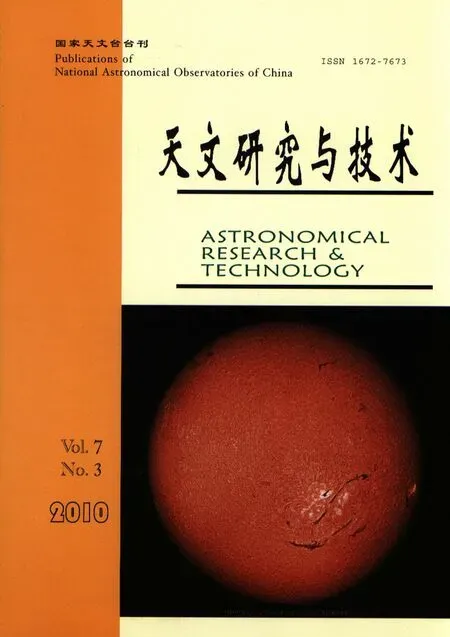水脉泽寄主活动星系核的吸积率*
2010-01-25张江水
王 金,张江水,郭 仟
(1.广州大学天体物理中心,广州 510006;2.天文观测与技术广东省高校重点实验室,广州 510006;3.湖南人文科技学院,娄底 417000)
1 Introduction
The H2O maser emission in extragalactic galaxies was first detected[1]ten years after the first detection of H2O maser in the Galaxy in 1969[2].At the beginning,similar to the Galactic masers extragalactic masers were found in massive star-forming regions in very nearby galaxies,such as M33 and IC 342[3].Later,surprisingly powerful H2O maser emission was detected in the nuclear regions of relative farther galaxies.Their derived isotropic luminosity values of 102~104L⊙exceed the median value of Galactic masers by~6 orders of magnitude,so AGN are considered to be their ultimate energy sources(——megamaser;hereafter AGN-masers).To date over 80%of detected H2O maser sources(~100)belong to this class.For AGN-masers,two possible scenarios of physical origins have been proposed: (1)the masers are related to the nuclear accretion processes and the maser spots locate within accreting molecular disks(disk masers);(2)the masers are related to the interactions of nuclear radio jets with ambient molecular clouds or to the amplifications of the important seed photons of jets by specially positioned foreground clouds(jet masers).Testing of the first scenario has made the AGN-masers targets of high-resolution VLBI(Very Long Baseline Interferometry).VLBI imaging provides one of the most effective methods to probe the innermost regions of host AGN of masers[4].The study of disk masers has also become one of the most active subjects in the field of maser sources for its potential cosmological applications[5].
So far among~1500 galaxies searched~100 galaxies have been detected with H2O maser emission[6].The detection rate is rather low and the underlying reasons should be complicated,including the sensitivitylimits,the beam effect,and short lifetime of maser emission.However,it cannot be ruled out that maser emission is intrinsic for some AGN:host AGN of H2O masers may have properties different from AGN without H2O masers.The maser emission has been suggested to be associated with galaxy nuclear activities.Both the nuclear X-ray radiation and mass of the central engine are thus supposedly correlated with maser emission[7-9].The accretion rate is one of the most important parameters for AGN evolution.Here we investigate the dimensionless and mass accretion rates for all published AGN-maser sources and further probe possible connection between maser emission and the accretion rate.The AGN-maser sample is compiled in section 2.In section 3,we derive the accretion rates for our sample from estimated black-hole(central engine)mass values and observed X-ray data.For comparison,a complete AGN sample without detected masers is also compiled.Possible connection of maser emission luminosities and the accretion rates for AGN-masers is further explored.We summarize our results in the final section.
2 The sample
High-resolution VLBI imaging results show that spots of AGN-masers are located mainly within the innermost regions of a few parsecs of galaxy nuclei,which are highly obscured(with absorption column densities NH>1023cm-2)[10-13].X-ray dala provide a penetrating view for such an obscured nuclear region,i.e.that without the degree of obscuration of the optical or infrared emission.With advances of X-ray telescopes in angular resolutions,energy resolutions and sensitivities,an increasing number of galaxies with H2O masers have been observed in X-ray.The X-ray measurements of 72 published AGN-maser sources[14]have been obtained with the ASCA,BeppoSAX,XMM-Newton,and Chandra.We retrieved the unabsorbed X-ray luminosities in the 2 ~10 keV band of 36 sources,with the values of 29 sources from Kondratko et al.(2006)[8],those of 5 from Greenhill et al.(2008)[13],and the values of 2 sources(NGC 1068 and NGC 7479)from Guo et al.(2009)[15]and Wang et al.(2009)[16],respectively(see Table 1 for details).The luminosity ranges given in Table 1 cover results from multiple observations,alternative fitting models,and the different reflection-efficiency values for Compton-thick sources(NH>1024cm-2).
3 Analysis and discussion
The velocity dispersions for our AGN-maser sample are compiled from literatures(see Col.3 in Table 1).Using the empirical M-σ relation

where α =8.13,β =4.02,σ =200 km s-1(Tremaine et al.(2002)[17]),we estimate the black-hole mass values for our AGN-masers.

Table 1 The accretion rates of host AGN of H2O maser
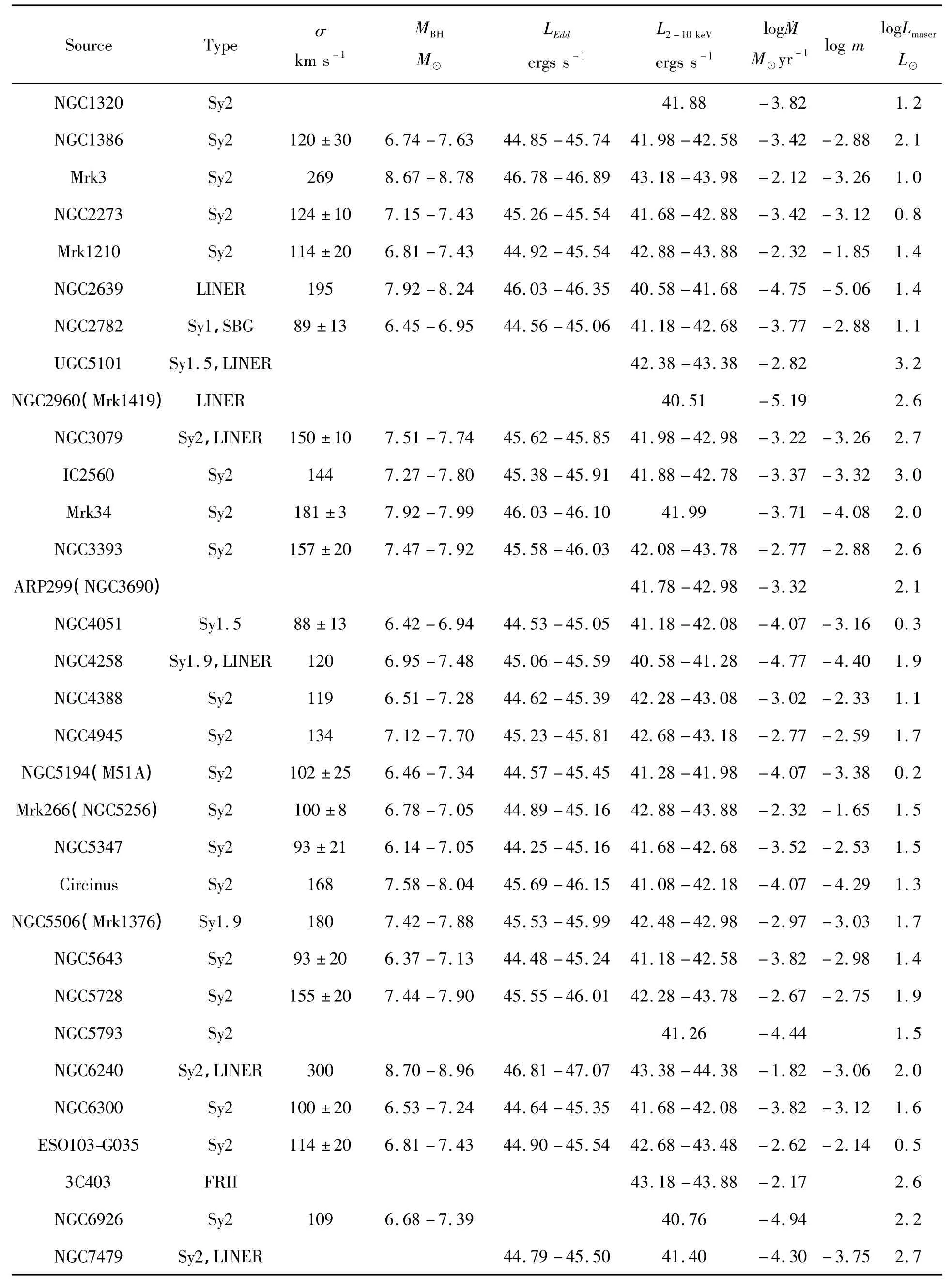
续表
Region;FRII:Fanarov-Riley type II galaxy.Column 3:the velocity dispersions(in km s-1)which are from Su et al.(2008)[9],except those of Mrk 3(from Woo et al.(2002)[18])and NGC7479(from McElroy et al.1995)[19].Column 4:the black-hole mass values derived from the empirical M-σ relation.The ranges reflect the uncertainty due to that of the velocity dispersions(for sources without known σ uncertainty,a ±30%uncertainty is adopted).Column 5:the logarithms of Eddington luminosities derived from the estimated black-hole mass values;Column 6:the intrinsic 2 - 10keV luminosities(in logL2-10keV)which are adapted from Kondratko et al.(2006)[8]except those of 5 sources(NGC1320,NGC2960,Mrk34,NGC5793,NGC6926,from Greenhill et al.2008)[13]and those of NGC1068(from Guo et al.2009)[15]and NGC7479(from Wang et al.2009[16].Column 7:the mass accretion rates(log˙M)derived from the estimated black-hole mass values(a median mass value is used in a case of multiple estimates).Column 8:the dimensionless accretion rates m(L2-10keV/LEdd,in logarithmic scale)derived from the intrinsic 2-10keV luminosities and Eddington luminosities(median values are taken in cases of multiple estimates of luminosity values).Column 9:the isotropic luminosities of maser emission(log LH2O,in units of L⊙),taken from Zhang et al.(2006)[12],Braatz & Gugliucci(2008)[20],and Darling et al.(2008)[21].

Table 2 The accretion rates of Sy2 galaxies without masers
The Eddington luminosities LEddof the sample can then be calculated from

and the dimensionless accretion rates m of our sample can be derived approximately as

(——correlated with Lbol/LEdd,see Winter et al.2009[22]).The results are listed in Table 1.
The mass accretion rates can be estimated following the method of Ishihara et al.(2001)[23].Assuming the standard accretion model,a stable rotating disk is formed down to three times the Schwarzschild radius,

Within the 3rgradius,mater cannot stay in any stable circular orbit but falls into the central black hole.About half of the gravitational energy is presumed to be transformed into radiation,

The mass accretion rate can be evaluated as

Using L2-10keVas a measure of L,the mass accretion rates are calculated for our maser sample and the results are included in Table 1.
3.1 The accretion rates of host AGN of H2O masers and AGN without masers
The lower panel of Figure 1 shows the distribution of the dimensionless accretion rates(in the logarithmic scale)for our host AGN of masers(29 sources).The number distribution of logL2-10keV/LEddpeaks at~ -3.5 to -3 and the mean value is -3.10±0.15.As mentioned above,comparison between AGN with and without detected H2O maser emission should be interesting for understanding the properties of H2O maser emission.Winter et al.(2009)[22]presented a uniform local AGN sample(z < 0.03)from the 9-month SWIFT BAT survey(Burst Alert Telescope).The depth of the sample is comparable to that of our maser sample.This sample is used here after excluding maser sources and Seyfert 1s(type 1-1.5),since H2O masers are mostly found in Seyfert 2 systems(just one in Seyfert 1:NGC2782).The 34 Sy2 AGN without known masers are presented in Table2,including their dimensionless accretion rates.For comparison,we plot the distribution of their dimensionless accretion rates in the upper panel of Figure 1.It peaks at~ -4 to -3.5 and the mean value is -3.47±0.12,which is less than that of our maser AGN.And the differences in distributions are significant according to the Kolmogorov-Smirnov test.The null hypothesis that both samples are drawn from the same parent population can be rejected at a confidence level of about 99.7%.
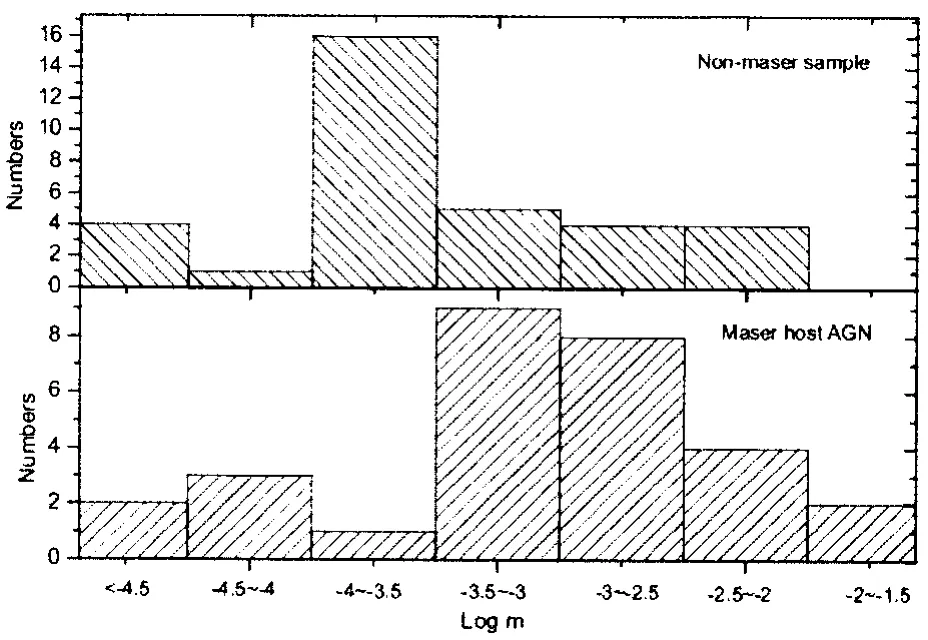
Fig.1 The number distributions of the dimensionless accretion rates m(L2-10 keV/LEdd,in logarithm)for host AGN of masers(lower panel)and AGN without known masers(upper panel),respectively
In Figure 2 we plot the number distributions of the mass accretion rates(log˙M)for both AGN hosting masers and AGN without masers.A similar trend can be found,i.e.,maser sources appear to have higher values of mass accretion rates with the host AGN and non-host AGN distributions peaking at~-3.5 to -3 and ~-4 to -3.5,respectively.
However,we have to note that our AGN-maser sample presented here may not be homogeneous.First,a diversity of maser types exists.Some maser sources show evidence of originating in rotating accretion disks and some are related to the nuclear radio jets.Second,some are Compton-thick(with the absorbing column densities along line of sight NH>1024cm-2)and others are Compton-thin(NH<1024cm-2).In addition,large uncertainties for their intrinsic 2 -10keV luminosities resulted from fitting the observed X-ray spectra,as they sensitively depend on used telescopes and models for fitting.In some cases,two or even more alternative models can fit the same spectra almost equally well but yield different flux values.Especially for Compton-thick sources,their X-ray luminosities should be dominated by the reflected components and the reflection rates are difficult to be determined.
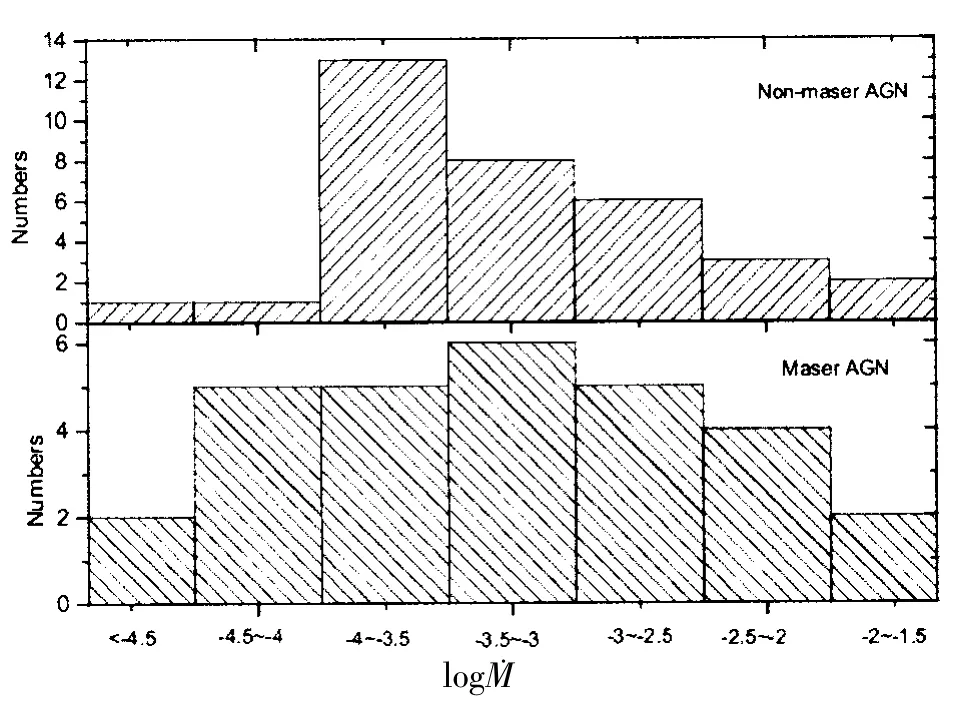
Fig.2 The number distributions of the mass accretion rate(log˙M)for host AGN of masers(lower panel)and AGN without masers(upper panel),respectively
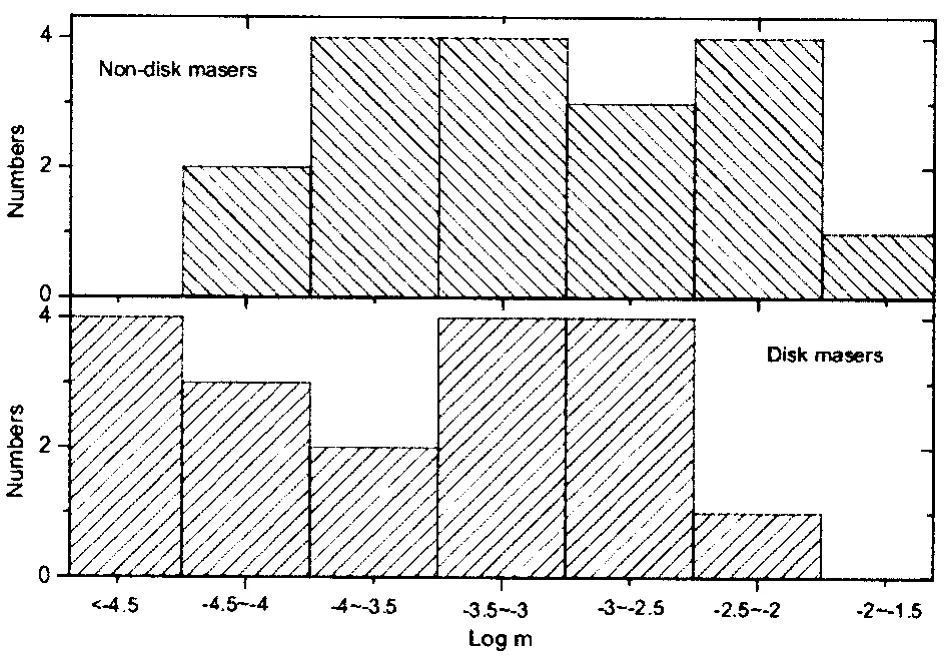
Fig.3 The number distributions of the dimensionless accretion rates of disk masers(lower panel)and non-disk masers(upper panel)
3.2 The accretion rates of disk maser and non-disk masers
Disk-maser sources as represented by that in NGC4258 are considered to show following special features:(1)maser spectral lines show three groups of components,at the systemic velocity of the host galaxy and two sets of high velocities,respectively( ±900 km s-1relative to the systemic velocity);(2)VLBI observations show that such maser spots are located at the nuclear region of a host galaxy,either in front of the source region of the central continuum radiation or on two sides of the center with high velocities,and(3)all spots are roughly at the same radius from the center.In short these maser spots should be in a rotating accretion disk and should naturally have accretion features.For our maser sample with available data,we extract a diskmaser subsample of 18 sources(see sources in bold-style names in Table 1)and a non-disk maser sample of 18 sources.We plot the distributions of the dimensionless accretion rates(Figure 3)and the mass accretion rates(Figure 4)for both subsamples.For both types of accretion rates,the distributions are similar for disk-maser and non-disk maser samples.However,no firm conclusion can be given here due to too small numbers of these two subsamples.
3.3 H2O maser emission and accretion rates
As mentioned above,AGN are considered as the energy sources of H2O megamasers.Under this scenario it is most likely that X-ray irradiation of molecular gas by the central engine excites the maser emission[7],as supported by the statistical analysis of the unabsorbed nuclear 2 -10keV luminosities(L2-10keV,as indicators of AGN powers)and the isotropic maser luminosities[8]. Accretion rates are characteristic parameters characterizing the powers of AGN(related to L2-10keV).It is thus natural to expect possible connection between accretion rates and maser emission luminosities.For our maser sample with available data,Figure 5 shows the mass accretion rate(lower panel)and the dimensionless rate(upper panel)versus the isotropic maser luminosity,respectively.No significant correlation between accretion rate and maser emission can be found for either disk-masers(triangle symbols)or non-disk masers(squared symbols).Actual uncertainties will be even larger due to possible time variations of maser radiation powers and deviations of maser emission from the isotropy,which can cause our used maser luminosity values biased.Therefore,we find no evidence supporting the X-ray irradiation model.
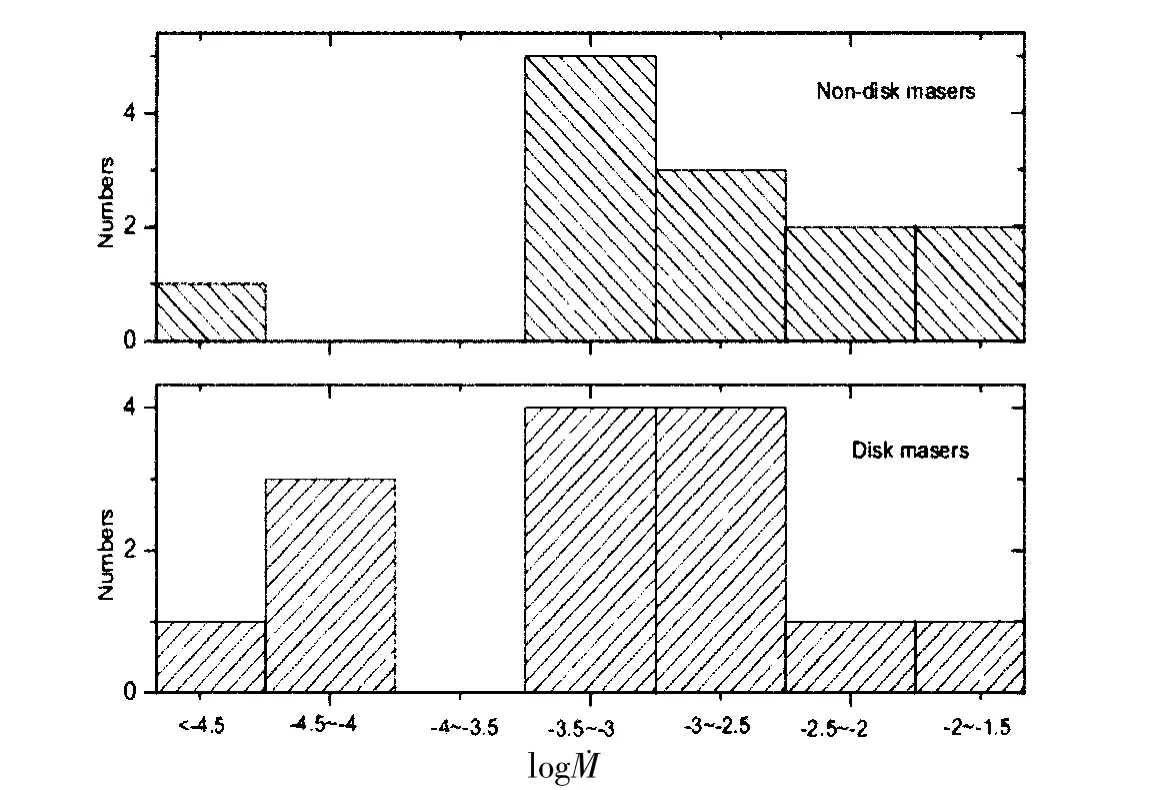
Fig.4 The number distributions of the mass accretion rates(log˙M)for disk masers(lower panel)and non-disk masers(upper panel)
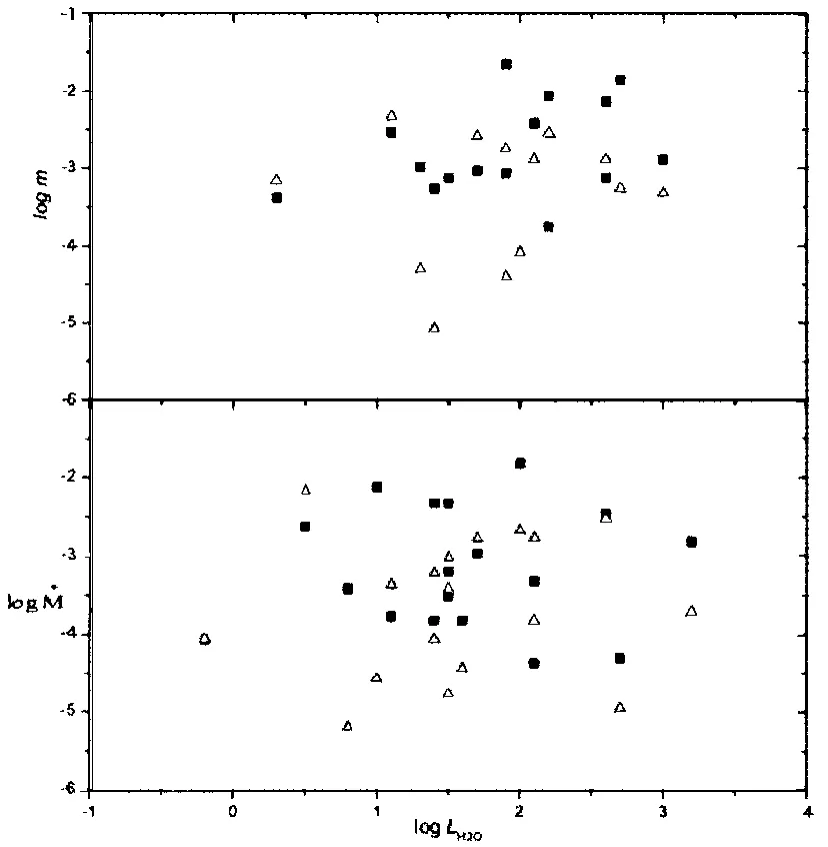
Fig.5 The dimensionless accretion rate(upper panel,log m)and mass accretion rate(lower panel,log˙M)versus the isotropic maser luminosity(log Lmaser,in L⊙).Triangles and squares denote disk-masers and non-disk masers,respectively
4 Conclusion
For AGN-maser sources with available X-ray measurements,their accretion rates(both mass accretion and dimensionless rates)are analyzed.For comparison,a complete AGN sample without detected masers is also compiled.The main results are summarized as follows:
(1)For host AGN of masers,the dimensionless accretion rates(logL2-10keV/LEdd)and the mass accretion rates(log˙M)are estimated.Both types of accretion rates of these AGN tend to be higher than those of AGN without masers.This means that accretion rates may be important for the formation of nuclear masers.It is valuable to investigate a larger AGN-maser sample in future;
(2)When comparing disk masers and non-disk masers,no significant difference in the distributions of accretion rates can be found.However,we notice that these two subsamples are too small to draw any definite conclusion;
(3)Possible connections between the accretion rates of AGN and maser luminosities is also investigated for our maser sample.Our statistical results do not show any correlation between them for either disk masers or non-disk masers.Large uncertainties of maser luminosity and accretion rates may have obscured a correlation.
Acknowledgements:This work is supported partly by the National Natural Scientific Foundation of China(10633010)and Guangdong Provincial Natural Science Foundation(8451009101001047).We made use of the NASA Astrophysics Data System Bibliographic Services(ADS),High-Energy Astrophysics Science and Research Center(HEASARC)and also the NASA/IPAC extragalactic Database(NED),which is operated by the Jet Propulsion Laboratory.
[1]Churchwell E,Witzel A,Huchtmeier W,et al.Detection of H2O maser emission in the Galaxy M 33 [J].A&A,1977,54:969.
[2]Cheung A C,Rank D M,Townes C H,et al.Detection of Water in Interstellar Regions by its Microwave Radiation [J].Nature,1969,221:626.
[3]Huchtmeier W K,Witzel A,Kuehr H,et al.Further detections of H2O-emission from external galaxies [J].A&A,1978,64:21.
[4]Morganti R,Greenhill L J,Peck A B,et al.Disks,tori,and cocoons:emission and absorption diagnostics of AGN environments [J].New Astron Rev,2004,48:1195.
[5]Braatz J A,Reid M J,Greenhill L J,et al.Water Masers in AGN Accretion Disks[J].ASPC,2009,402:274.
[6]Bennert N,Barvainis R,Henkel C,et al.A Search for H2O Megamasers in High-z Type-2 AGN [J].ApJ,2009,695:276.
[7]Neudeld D A,Maloney P R,Conger S.H2O maser emission from X-ray-heated circumnuclear gas in active galaxies [J].ApJ,1994,436:L127.
[8]Kondratko P T,Greenhill L J,Moran J M.Discovery of Water Maser Emission in Five AGNs and a Possible Correlation Between Water Maser and Nuclear 2 -10 keV Luminosities[J].ApJ,2006,652:136.
[9]Su J B,Zhang J S,Fan J H.Extragalactic H2O Megamaser Sources:Central Black Holes,Nuclear X-ray and Maser Emissions [J].ChJAA,2008,8:547.
[10]Braatz J A,Wilson A S,Henkel C.A Survey for H2O Megamasers in Active Galactic Nuclei.II.A Comparison of Detected and Undetected Galaxies [J].ApJS,1997,110:321.
[11]Madejski G,Done C,Zycki P T,et al.X-Ray Emission from Megamaser Galaxy IC 2560[J].ApJ,2006,636:75.
[12]Zhang J S,Henkel C,Kadler M,et al.Extragalactic H2O masers and X-ray absorbing column densities [J].A&A,2006,450:933.
[13]Greenhill L J,Tilak A,Madejski G.Prevalence of high X-ray obscuring columns among AGNs that host H2O masers [J].ApJ,2008,686:L13.
[14]Zhang J S,Henkel C,Guo Q,et al.On the nuclear obscuration of H2O maser galaxies[J].accepted by ApJ,2009.
[15]Guo Q,Zhang J S,Fan J H.On the X-ray properties of H2O maser host galaxies[J].IJMPD,2009,1809,1367:1379.
[16]Wang J,Zhang J S,Fan J H.XMM-Newton observations of H2O maser galaxies NGC7479[J].Submitted to RAA,2009.
[17]Tremaine S,Gebhardt K,Bender R,et al.The Slope of the Black Hole Mass versus Velocity Dispersion Correlation [J].ApJ,2002,574:740.
[18]Woo J H,Urry C M.Active Galactic Nucleus Black Hole Masses and Bolometric Luminosities[J].ApJ,2002,579:530.
[19]McElroy,Douglas B.A catalog of stellar velocity dispersions.II.1994 Update [J].ApJS,1995,100:105.
[20]Braatz J A,Gugliucci N E.The Discovery of Water Maser Emission from Eight Nearby Galaxies[J].ApJ,2008,678:96.
[21]Darling J,Brogan C,Johnson K.Ubiquitous Water Masers in Nearby Star-Forming Galaxies[J].ApJ,2008,685:39.
[22]Winter L M,Mushotzky R F,Reynolds C S,et al.The Slope of the Black Hole Mass versus Velocity Dispersion Correlation [J].ApJ,2009,690:1322.
[23]Ishihara Y,Nakai N,Iyomoto N,et al.Water-Vapor Maser Emission from the Seyfert 2 Galaxy IC 2560:Evidence for a Super-Massive Black Hole [J].PASJ,2001,53:215.
